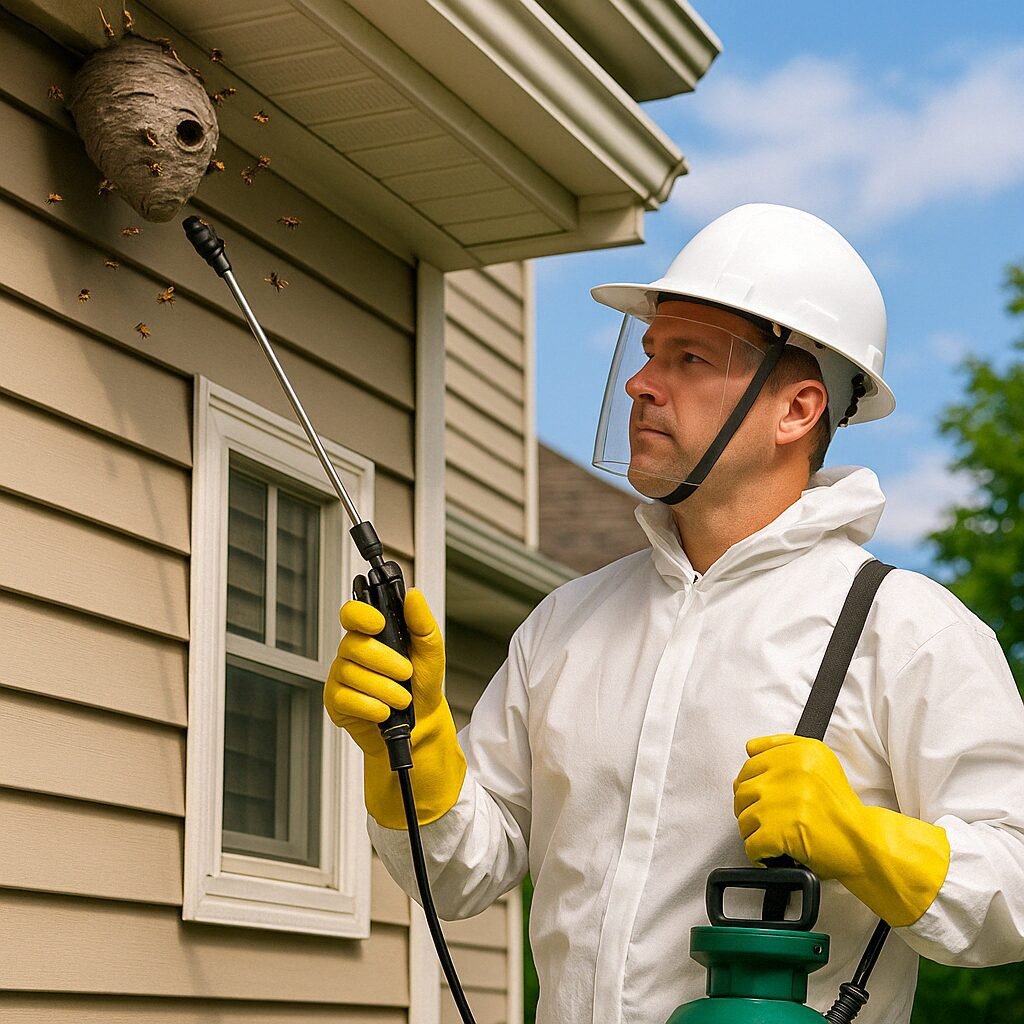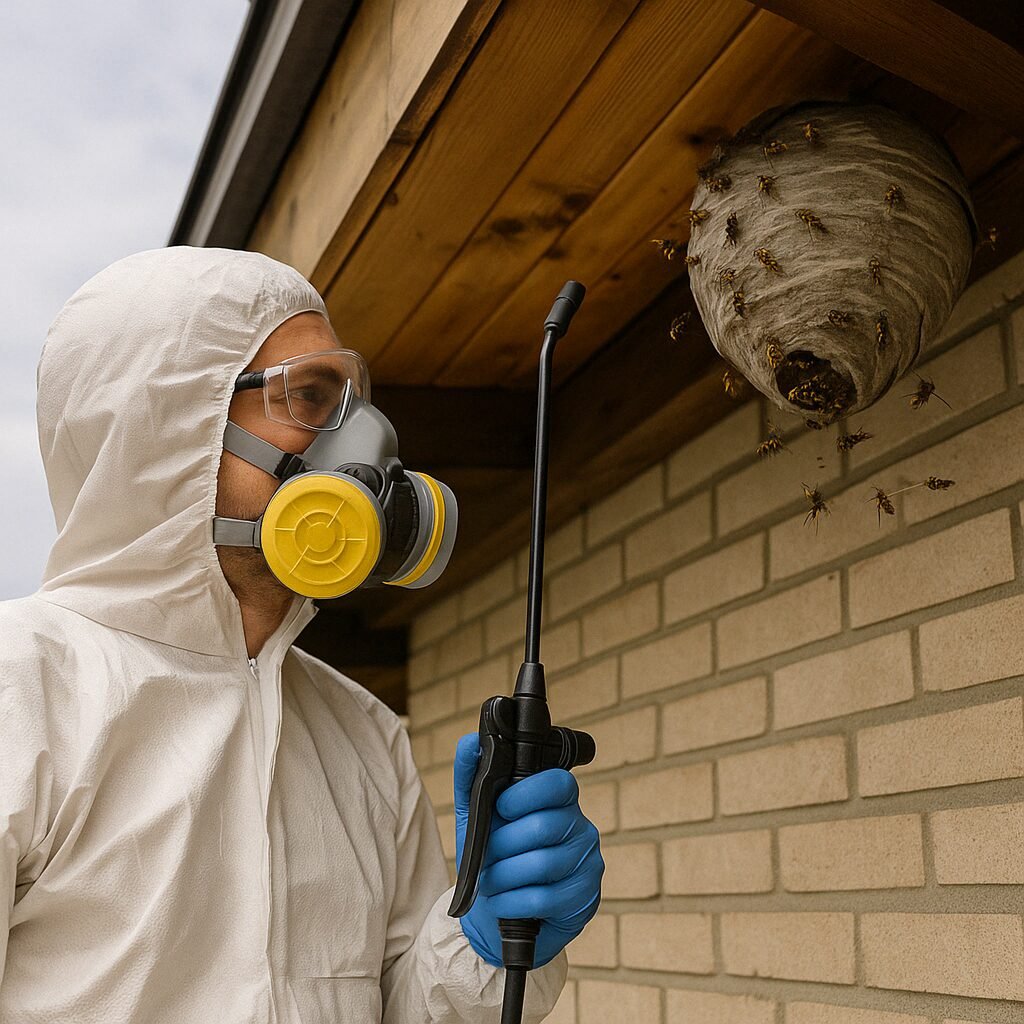Protect your property from stinging insects with Touchdown Pest Control. We provide safe and effective bee removal pest control and wasp pest control to prevent harm and restore peace of mind. Call today for expert stinging insect control, prevention services, and certified bee exterminator solutions.
Bees, wasps, and hornets can turn a peaceful yard into a danger zone—especially when nests are close to entrances, attics, or high-traffic areas. Their stings can cause pain, allergic reactions, and serious risk for children and pets.
Touchdown Pest Control offers safe, effective pest control for wasps and professional bee control services to protect your home and family. Our licensed pest experts use humane, eco-friendly methods to eliminate stinging insects without risk to your household. Whether it’s aggressive wasps in Los Angeles nesting under your eaves or a swarm of bees in your shed, we’re equipped to handle it quickly and professionally.
Dealing with stinging insects on your property? We provide fast, reliable bee, wasp, and hornet removal services. Call now to speak with a certified technician.
Bees, wasps, and hornets typically build nests in eaves, trees, attics, sheds, and wall voids. To reduce the chances of stings or infestations:
Avoid disturbing nests
Keep food and trash sealed outdoors
Wear light-colored clothing
Avoid perfumes outdoors
Inspect your home’s exterior regularly for small nests in early spring. Early detection allows safer removal before colonies grow. Avoid DIY spraying—fumigation for wasps and bee hives should only be handled by professionals.
For best results, trust Touchdown Pest Control’s certified team for safe bee removal pest control or wasps pest control.



Stinging insects like bees, wasps, and hornets pose serious health risks. Touchdown Pest Control offers professional wasp pest control and bee exterminator services, using eco-conscious techniques. We eliminate active nests and help prevent reinfestation through exclusion and prevention.
Bees, wasps, and hornets defend their nests aggressively. While one sting may cause discomfort, multiple stings or allergic reactions can be dangerous. Children and pets are at higher risk when nests are near doors, patios, or play areas.
If you notice a nest, don’t attempt DIY removal—professional bee exterminator or pest control bees service ensures safety.
Wasps and hornets are typically more aggressive than bees and are identifiable by their slender, elongated bodies and shiny, hairless appearance. Bees are generally more docile, rounder, and hairy, and may be seen pollinating flowers. Nests can vary—paper wasps build umbrella-shaped nests, hornets create large ball-shaped structures, and bees form waxy hives in sheltered areas.
Nests can appear under eaves, in attics, trees, walls, sheds, or even underground. Early detection is crucial. A small nest in spring can grow into a large, aggressive colony by summer. If buzzing activity increases or you spot a visible nest, avoid the area and call for professional help immediately.
Queen wasps and hornets start new nests each spring. As the colony grows, so does the risk of stings and aggressive behavior. Colonies may house hundreds to thousands of stinging insects by late summer. Without removal, these pests can return yearly or even expand into other parts of your property.
DIY removal of wasps in Los Angeles is dangerous and often ineffective. Touchdown Pest Control provides safe fumigation for wasps, bee control, and hornet extermination with protective equipment and expert techniques.
Never attempt to spray or knock down a wasp or hornet nest yourself. If you notice heightened insect activity or a visible nest near your home, contact Touchdown Pest Control. Our expert team will assess the situation and safely remove the threat—giving you peace of mind and a sting-free property.
Stings can cause pain and allergic reactions. Pest control bees and wasps pest control services ensure safety.
Under eaves, attics, trees, sheds, wall voids, or underground.
Seal gaps, keep spaces clean, use screens, and reduce lighting.
It can provoke swarms. Professional bee exterminator or pest control for wasps is safer.
Certified methods, protective equipment, eco-friendly techniques, and targeted bee removal pest control.
Anaheim – Anaheim Hills – Corona – Covina – Eastvale – Fontana – Fullerton – Glendora – Irvine – Long Beach – Los Angeles – Monrovia – Moreno Valley – Norco – Ontario – Orange – Orange County – Pasadena – Reseda – Riverside – Santa Ana – Van Nuys – Whittier – Woodland Hills
Touchdown Pest Control
We firmly believe that the internet should be available and accessible to anyone, and are committed to providing a website that is accessible to the widest possible audience, regardless of circumstance and ability.
To fulfill this, we aim to adhere as strictly as possible to the World Wide Web Consortium’s (W3C) Web Content Accessibility Guidelines 2.1 (WCAG 2.1) at the AA level. These guidelines explain how to make web content accessible to people with a wide array of disabilities. Complying with those guidelines helps us ensure that the website is accessible to all people: blind people, people with motor impairments, visual impairment, cognitive disabilities, and more.
This website utilizes various technologies that are meant to make it as accessible as possible at all times. We utilize an accessibility interface that allows persons with specific disabilities to adjust the website’s UI (user interface) and design it to their personal needs.
Additionally, the website utilizes an AI-based application that runs in the background and optimizes its accessibility level constantly. This application remediates the website’s HTML, adapts Its functionality and behavior for screen-readers used by the blind users, and for keyboard functions used by individuals with motor impairments.
If you’ve found a malfunction or have ideas for improvement, we’ll be happy to hear from you. You can reach out to the website’s operators by using the following email
Our website implements the ARIA attributes (Accessible Rich Internet Applications) technique, alongside various different behavioral changes, to ensure blind users visiting with screen-readers are able to read, comprehend, and enjoy the website’s functions. As soon as a user with a screen-reader enters your site, they immediately receive a prompt to enter the Screen-Reader Profile so they can browse and operate your site effectively. Here’s how our website covers some of the most important screen-reader requirements, alongside console screenshots of code examples:
Screen-reader optimization: we run a background process that learns the website’s components from top to bottom, to ensure ongoing compliance even when updating the website. In this process, we provide screen-readers with meaningful data using the ARIA set of attributes. For example, we provide accurate form labels; descriptions for actionable icons (social media icons, search icons, cart icons, etc.); validation guidance for form inputs; element roles such as buttons, menus, modal dialogues (popups), and others. Additionally, the background process scans all the website’s images and provides an accurate and meaningful image-object-recognition-based description as an ALT (alternate text) tag for images that are not described. It will also extract texts that are embedded within the image, using an OCR (optical character recognition) technology. To turn on screen-reader adjustments at any time, users need only to press the Alt+1 keyboard combination. Screen-reader users also get automatic announcements to turn the Screen-reader mode on as soon as they enter the website.
These adjustments are compatible with all popular screen readers, including JAWS and NVDA.
Keyboard navigation optimization: The background process also adjusts the website’s HTML, and adds various behaviors using JavaScript code to make the website operable by the keyboard. This includes the ability to navigate the website using the Tab and Shift+Tab keys, operate dropdowns with the arrow keys, close them with Esc, trigger buttons and links using the Enter key, navigate between radio and checkbox elements using the arrow keys, and fill them in with the Spacebar or Enter key.Additionally, keyboard users will find quick-navigation and content-skip menus, available at any time by clicking Alt+1, or as the first elements of the site while navigating with the keyboard. The background process also handles triggered popups by moving the keyboard focus towards them as soon as they appear, and not allow the focus drift outside it.
Users can also use shortcuts such as “M” (menus), “H” (headings), “F” (forms), “B” (buttons), and “G” (graphics) to jump to specific elements.
We aim to support the widest array of browsers and assistive technologies as possible, so our users can choose the best fitting tools for them, with as few limitations as possible. Therefore, we have worked very hard to be able to support all major systems that comprise over 95% of the user market share including Google Chrome, Mozilla Firefox, Apple Safari, Opera and Microsoft Edge, JAWS and NVDA (screen readers).
Despite our very best efforts to allow anybody to adjust the website to their needs. There may still be pages or sections that are not fully accessible, are in the process of becoming accessible, or are lacking an adequate technological solution to make them accessible. Still, we are continually improving our accessibility, adding, updating and improving its options and features, and developing and adopting new technologies. All this is meant to reach the optimal level of accessibility, following technological advancements. For any assistance, please reach out to